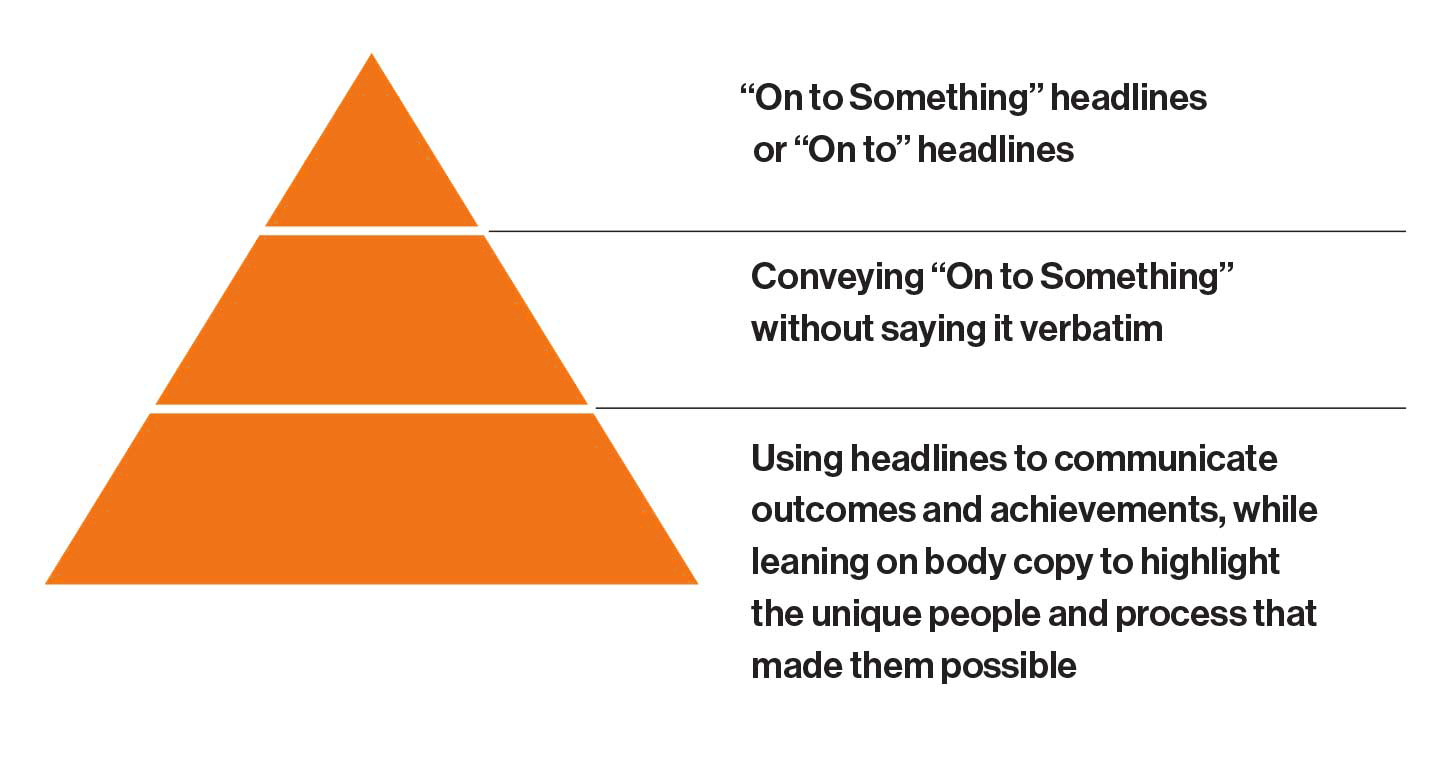Voice and Tone
Breadcrumb
- RIT/
- Brand Portal/
- Brand Elements/
- Voice and Tone
In the simplest terms, our message is what we say and our voice is how we say it.
Still, it’s practically impossible to separate the two: they must always be true to each other. And it’s through our tone—informed by our brand personality traits and based on our creative platform—that our voice takes shape, expressing who we are in a way that’s unmistakably RIT
General Writing Tips
Good writing feels purposeful, intentional, and above all, believable. Here are several principles to keep in mind when crafting your next communication.
Know who you're talking to.
From prospective students to international students, from alumni to regional business leaders, our audiences are varied, and so are their interests. With every message you send, put yourself in your target audience’s shoes and ask: “Does this sound like something that would resonate with them?”
Move people to do something.
Every piece of communication you create has a purpose. And whether it’s driving readers to a website or asking people to make a gift to the university, it’s critical to include a call to action so the audience knows what you want them to do.
Get personal.
Personal stories go a long way. Not only do they add a human element to our brand, but they’re living proof of the things we say about our institution.
Avoid clichés and jargon.
We are an institution unlike any other. Our stories are unique, and the copy that supports them should be unique, too. Stay away from cliché phrases and overused jargon that make us sound like every other university.
Reward your audience.
Pay off your headline, get to the point, support it well, and finish strong. The goal is to get your reader all the way to the end.
“On to Something“ Usage
It’s inspiring, and it sets the tone for our writing and brand language. But the creative platform is more than a set of poetic phrases: It encompasses our entire messaging strategy and sparks it to life. Although it shouldn’t be used word for word when communicating externally, use it as inspiration or a gut-check for sharing our story.
At RIT, we leave the status quo to someone else.
That’s why we reject the everyday and the expected, and instead:
We advance the exceptional.
Develop the unconventional.
Elevate the delightful.
We lead with the idea of being an incubator for the exceptional.
We’re a kaleidoscope of curious minds—each embraced for our uniqueness and all working toward countless different goals.
This section talks about who we are, homing in on our core message about being inquisitive people, while also alluding to diversity.
But we’re united in the chase for a certain feeling:
When our eyes widen and our jaws drop.
When our hearts beat faster with the anticipation of discovery.
The idea of being united creates a sense of community. At RIT, even though we are individuals, we are all embraced.
It could happen anywhere, at any time.
And at RIT, we’ve intentionally created a place where these moments happen over and over again.
This paragraph refers to the academic experience that we create—our programs—and how they empower us to generate original thoughts and implement new ideas.
A place where something amazing is always right around the corner.
This is the overarching idea. It hints at our unique people and the unique way they go about solving problems, creating, and innovating.
It might be something slightly unusual.
It might be something wildly creative.
Or even something theoretically impossible.
These sentences speak to our innovative and creative nature, which is at the core of what we do. It also includes language about our distinctive mindset and our approach to solving problems.
It might be something no one has thought of yet, but there it is, right in front of us, just waiting to be made real.
Whatever that something is, we go after it with everything we have. We observe, we analyze, and we untangle. We tinker, we test, and we prove. We teach and learn from each other. We solve problems, and then seek out new ones.
This section talks about hard work, and our insatiable desire to discover, explore, and improve.
Because this is what we live for: The unbridled energy and exhilaration that comes from achieving something. Perfecting something.
Because here,
We're always on to something amazing.
Brand Voice and Tone Examples
Here are examples of how to adapt the brand voice and tone to different audiences while still sounding consistent.
AUDIENCE: Prospective Students
Voice: unusual, imaginative, open-minded, active
The best way to study international medicine is to study abroad.
NOT: DULL
Student studies abroad in Chile.
AUDIENCE: The Internal Community
Voice: unusual, imaginative, open-minded
This is a place where you can make your wildest ideas real.
NOT: OVERLY EXCITED
You’ll be more successful here than anywhere else in the country!
AUDIENCE: The Higher Education Community
Voice: unusual, open-minded, future-focused
RIT is one step closer to carbon neutrality.
NOT: COMPLICATED
RIT’s new 6.5 acre, 2-megawatt solar energy farm with 6,138 photovoltaic panels.
AUDIENCE: Alumni and Donors
Voice: future-focused, imaginative, active
RIT Alumni: 13 Pulitzer Prize Winners and Counting.
NOT: PRETENTIOUS
Better than the rest: RIT alumni have won the Pulitzer Prize 13 times.
AUDIENCE: Partners and Employers
Voice: active, imaginative, open-minded
Designing a future without fossil fuels.
NOT: HEAVY-HANDED
If we don’t stop relying on fossil fuels, the world as we know it will end.
Headline Hierarchy
“On to Something” is our creative platform, but it’s not a tagline. Is it a headline construct? Sometimes. But using the words “on to something” in every headline can get repetitive, so we don’t rely on that construction all the time. Use the pyramid below as a guide when you’re writing headlines.
Writing Headlines
The smallest portion at the top represents the times we use “on to something” verbatim, and the largest portion at the bottom represents the headlines we use much more frequently.

How to Write Headlines
For high-level pieces like viewbook covers or billboards, these techniques are the best way to make a succinct, powerful impression on a wide audience. There are two ways to use “on to something” in a headline:
“On to Something” Headlines
On to something + [qualifier] To keep this phrase fresh, combine it with a descriptive qualifier that conveys the type of work being done and the type of passion and intensity that go into it.
Examples
On to something wildly creative.
On to something extraordinary.
On to something remarkable.
“On to” Headlines
On to + [high-level idea or specific experience] Use this device to convey high-level ideas that apply to a broad number of people, and to build language around specific stories of individuals. This headline construct should also be used more frequently for NTID and international audiences, since “on to something” is an idiom that’s not conveyed as easily through translation.
Examples
You're on to an experience unlike any other.
On to the next big thing.
On to a better internet.
Conveying “On to Something” Without Saying it Verbatim
There are many different ways to convey the feeling of “On to Something.” Use words and phrases like these to keep our language varied while still communicating clearly.
Examples
- Countless
- Infinite
- Next
- Forward
- Advancing
- Momentum
- Pace
- Ahead
- Progressing
- Building
- Driving
- Pursuing
- Endless
- Constant
- Motion
- Ceaseless
- Limitless
- Perpetual
- Continuous
- Relentless
- Insatiable
Body Copy
When writing body copy, we want to both convey the message of “On to Something” and pay it off effectively. By balancing our language between the things we achieve and the things that are ahead, we can demonstrate the uniqueness of our approach, the people behind the process, and the results that they yield.
Here is an example of what that might look like for a piece about NTID:
You’re on to a world of possibilities.
The National Technical Institute for the Deaf (NTID) provides unmatched opportunities for deaf and hard-of-hearing students. You’ll receive the career-focused, innovative curriculum RIT is known for, all within an accessible and supportive learning environment that’s equipped with the tools and resources you need to reach your next goal.






